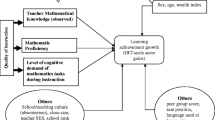Abstract
This study analyzes measurement learning expectations involving area and volume in grades 1–8 across several U.S. states and high-performing TIMSS Asian countries, including Singapore, Taiwan, and Japan. Based on a review of official curriculum documents, results of this study indicate that the mathematics content, grade placement, and cognitive level of learning expectations related to selected measurement topics vary markedly across states and countries. This variability in learning expectations results in striking differences in students’ opportunity to learn.
Similar content being viewed by others
References
Achieve, Inc., (2004). Mathematics Achievement Partnership, K-8 Mathematics Expectations, December 2004 Draft. Available: http://www.achieve.org/.
Bakeman, R. (2000). Behavioral observation and coding. In H.T. Reis & C.M. Judge (Eds.), Handbook of research methods in social and personality psychology. New York: Cambridge University Press.
CCSSO (1999). Survey of instructional content grade K-8 mathematics. Washington, DC: Council of Chief State School Officers.
Chen, J.C. (2005). Analysis of selected geometry and measurement learning expectations in some Asian countries and U.S. states as specified in national and state curriculum documents. Columbia, USA: Doctoral dissertation, University of Missouri.
De Lange, J. (2007). Large-scale assessment of mathematics education. In F.K. Lester (Ed.), Second handbook of research on mathematics teaching and learning (pp. 1111–1144. )Charlotte, NC: Information Age Publishing.
Floden, R.E. (2002). The measurement of opportunity to learn. In C. P. Andrew & A. Gamoran (Eds.), Methodological advances in cross-national surveys of educational achievement. Washington, DC: National Academy Press.
Kloosterman, P. & Lester, F.K. (2004). Results and interpretations of the 1990–2000 mathematics assessments of the national assessment of educational progress. Reston, VA: National Council of Teachers of Mathematics.
Kolbe, R.H. & Burnett, M.S. (1991). Content-analysis research: An examination of applications with directives for improving research reliability and objectivity. Journal of Consumer Research, 18, 243–250.
McKnight, C.C., Crosswhite, F.J., Dossey, J.A., Kifer, E., Swafford, J.O., Travers, K.J. & Cooney, T.J. (1987). The underachieving curriculum: assessing U.S. school mathematics from an international perspective. Champaign, Illinois: Stipes Publishing Company.
National Council of Teachers of Mathematics. (2000). Principles and Standards for School Mathematics. Reston, VA: Author.
Porter, A.C. (2002). Measuring the content of instruction: uses in research and practice. Educational Researcher, 31(7), 3–14. October.
Reys, B.J.(Ed.). (2006). The intended mathematics curriculum as represented in state-level curriculum standards, Charlotte, NC: Information Age Publishing.
Reys, B.J., Robinson, E., Sconiers, S. & Mark, J. (1999). Mathematics curricula based on rigorous national standards: What, why and how? Phi Delta Kappan, 80(6), 454–456.
Schmidt, W.H., McKnight, C.C., Valverde, G.A., Houang, R.T. & Wiley, D.E. (1997). Many visions, many aims, volume 1. A cross-national investigation of curricular intentions in school mathematics. TIMSS, Boston: Kluwer Academic Publishers.
Schmidt, W.H., McKnight, C.C., Houang, R.T., Wang, H.C., Wiley, D.E., Cogan, L.S. & Wolfe, R.G. (2001). Why schools matter: a cross-national comparison of curriculum and learning. San Francisco, CA, USA: JOSSEY-BASS, A Wiley Company.
The No Child Left Behind Act. (2001). Public Law No. 107–110. Retrieved January 13, 2005, from http://www.ed.gov/policy/elsec/leg/esea02/index.html.
Valverde, G.A., Bianchi, L.J., Wolfe, R.G., Schmidt, W.H. & Houang, R.T. (2002). According to the book: using TIMSS to investigate the translation of policy into practice through the world of textbooks. The Netherlands: Kluwer Academic Publishers.
Venezky, R.L. (1996). Textbooks in school and society. In P. W. Jackson (Ed.), Handbook of research on curriculum. A project of the American educational research association. New York: Simon & Schuster Macmillan.
Webb, N.L. (1993). Mathematics education reform in California. In OECD documents: proceedings of a conference. Science and mathematics education in the United States: Eight innovations. (pp. 117–142. )France: OECD.
Weiss, I., Pasley, J., Smith, P., Banilower, E. & Heck, D. (2003). Looking inside the classroom: a study of k-12 mathematics and science education in the United States. Chapel Hill, NC: Horizon Research.
Whitman, D. (2004). The mad, mad world of textbook adoption. Washington, DC: Thomas B. Fordham Institute.
Wilson, L.D. & Blank, R.K. (1999). Improving Mathematics Education Using Results from NAEP and TIMSS. Council of Chief State School Officers, State Education Assessment Center.
Yaffee, R.A. (2005). Common correlation and reliability analysis with SPSS for Windows. Retrieved June 30, 2005, from http://www.nyu.edu/its/socsci/Docs/correlate.html
Author information
Authors and Affiliations
Corresponding author
Rights and permissions
About this article
Cite this article
Chen, J.C., Reys, B.J. & Reys, R.E. ANALYSIS OF THE LEARNING EXPECTATIONS RELATED TO GRADE 1–8 MEASUREMENT IN SOME COUNTRIES. Int J of Sci and Math Educ 7, 1013–1031 (2009). https://doi.org/10.1007/s10763-008-9148-5
Received:
Accepted:
Published:
Issue Date:
DOI: https://doi.org/10.1007/s10763-008-9148-5




